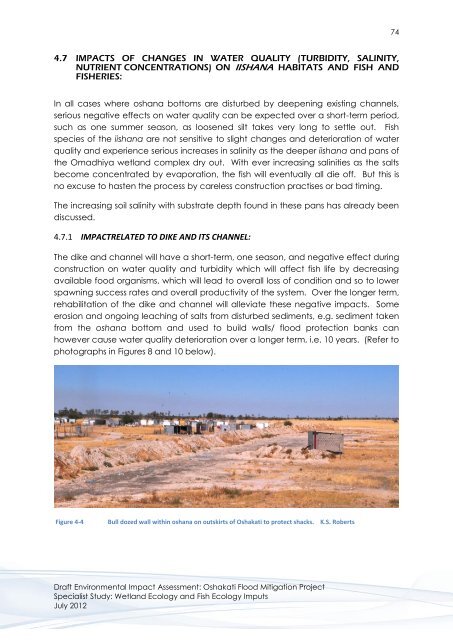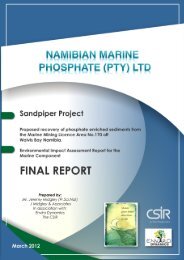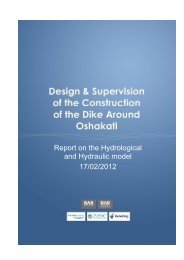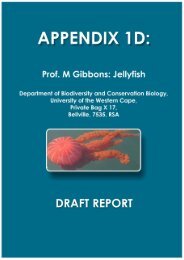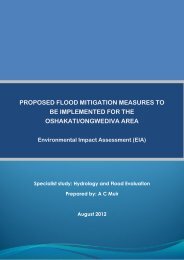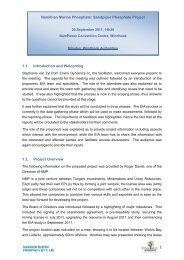Wetland & Fish Ecology - Enviro Dynamics Namibia
Wetland & Fish Ecology - Enviro Dynamics Namibia
Wetland & Fish Ecology - Enviro Dynamics Namibia
You also want an ePaper? Increase the reach of your titles
YUMPU automatically turns print PDFs into web optimized ePapers that Google loves.
74<br />
4.7 IMPACTS OF CHANGES IN WATER QUALITY (TURBIDITY, SALINITY,<br />
NUTRIENT CONCENTRATIONS) ON IISHANA HABITATS AND FISH AND<br />
FISHERIES:<br />
In all cases where oshana bottoms are disturbed by deepening existing channels,<br />
serious negative effects on water quality can be expected over a short-term period,<br />
such as one summer season, as loosened silt takes very long to settle out. <strong>Fish</strong><br />
species of the iishana are not sensitive to slight changes and deterioration of water<br />
quality and experience serious increases in salinity as the deeper iishana and pans of<br />
the Omadhiya wetland complex dry out. With ever increasing salinities as the salts<br />
become concentrated by evaporation, the fish will eventually all die off. But this is<br />
no excuse to hasten the process by careless construction practises or bad timing.<br />
The increasing soil salinity with substrate depth found in these pans has already been<br />
discussed.<br />
4.7.1 IMPACTRELATED TO DIKE AND ITS CHANNEL:<br />
The dike and channel will have a short-term, one season, and negative effect during<br />
construction on water quality and turbidity which will affect fish life by decreasing<br />
available food organisms, which will lead to overall loss of condition and so to lower<br />
spawning success rates and overall productivity of the system. Over the longer term,<br />
rehabilitation of the dike and channel will alleviate these negative impacts. Some<br />
erosion and ongoing leaching of salts from disturbed sediments, e.g. sediment taken<br />
from the oshana bottom and used to build walls/ flood protection banks can<br />
however cause water quality deterioration over a longer term, i.e. 10 years. (Refer to<br />
photographs in Figures 8 and 10 below).<br />
Figure 4-4 Bull dozed wall within oshana on outskirts of Oshakati to protect shacks. K.S. Roberts<br />
Draft <strong>Enviro</strong>nmental Impact Assessment: Oshakati Flood Mitigation Project<br />
Specialist Study: <strong>Wetland</strong> <strong>Ecology</strong> and <strong>Fish</strong> <strong>Ecology</strong> Imputs<br />
July 2012


